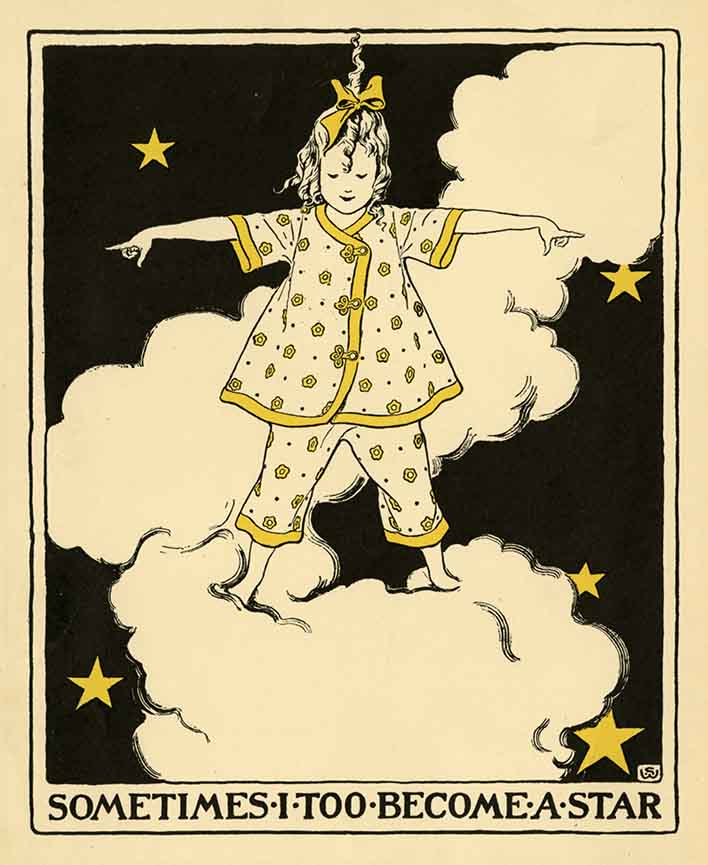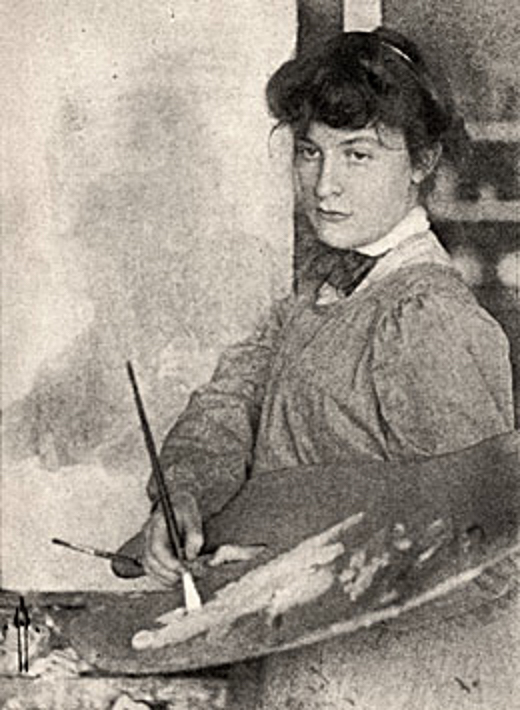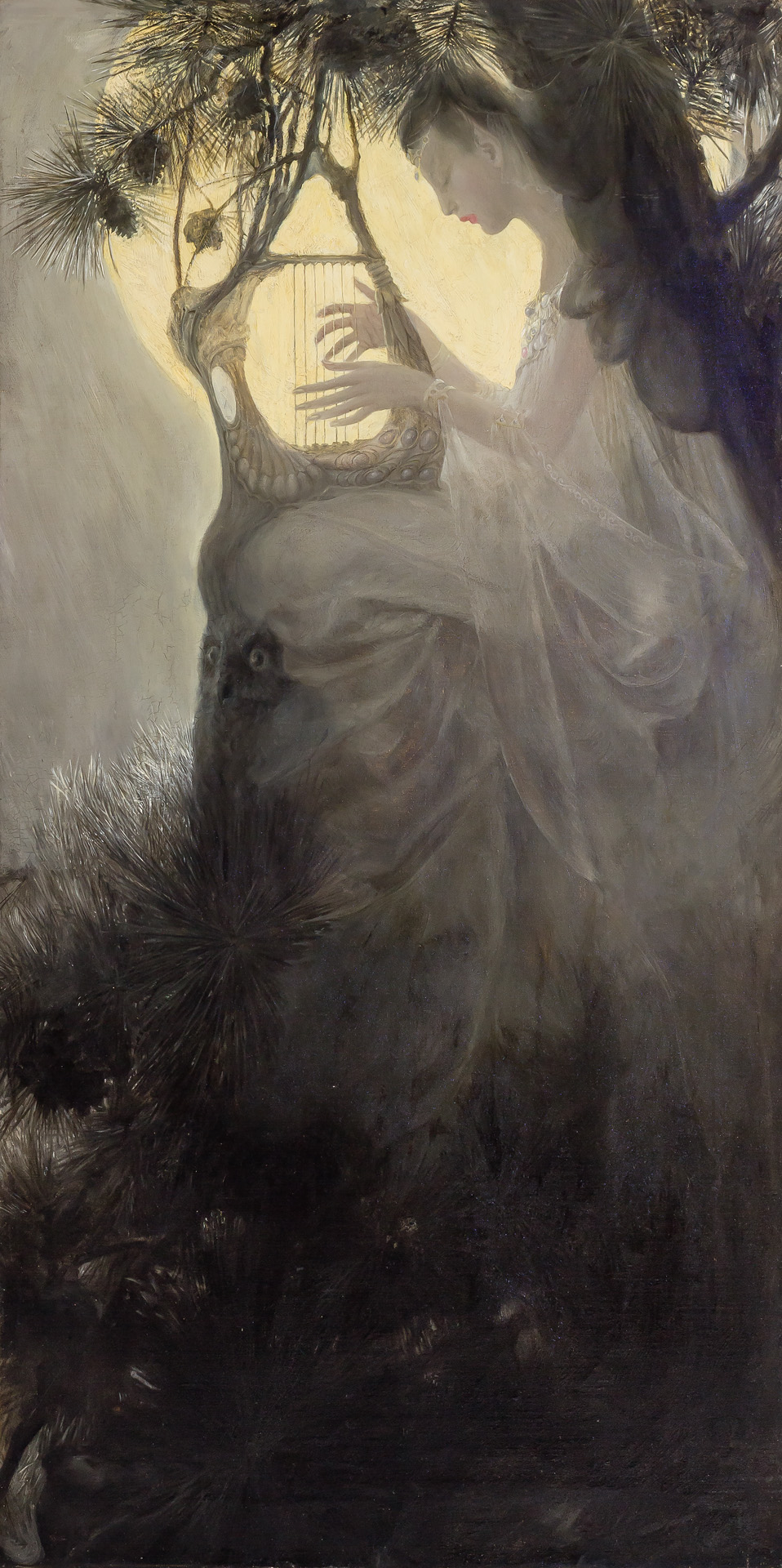Newsletter
The Two Red Roses Foundation has recently acquired a significant painting by American artist and illustrator Sarah S. Stilwell Weber (1878-1939). Harmony in the Light of the Moon, c. 1903, exemplifies the work of Weber, one of the best known and highest paid illustrators in America during her lifetime.
Weber’s art education began at Philadelphia’s Drexel Institute in 1897, when her budding talent earned her entry into the popular courses taught by Howard Pyle, considered “the Father of American Illustration.” She later attended Pyle’s own school at Chadds Ford on the Brandywine River. Artists who studied there came to be known as the Brandywine School of Illustrators. One of Pyle’s favorites, Weber was among a small group of students permitted to move into in his studio in Wilmington, Delaware, and his assistance helped launch her career. Weber was also an early member of the Plastic Club, an association founded in 1897 for the promotion and exhibition of art by women that is now one of the oldest art clubs in the country. Other noteworthy members at the time included Weber’s Drexel classmates Elizabeth Shippen Green, Jessie Willcox Smith, and Violet Oakley. During her successful career, Weber created numerous advertisements for companies such as Wamsutta Mills and Rit Dyes, and magazine and book illustrations for clients including Harper’s Bazaar, Collier’s, Scribners, Vogue, and St. Nicholas Magazine. Weber created her first cover for the Saturday Evening Post in 1904, the year they began hiring female illustrators, and she eventually completed sixty covers for them.

Sarah Stilwell Weber, Sometimes I Too Become a Star, from The Musical Tree. TRRF Rare Book Collection.
Weber is best known for her numerous endearing images of children, her favorite subject. A mother herself, her works in ink, watercolor, and oil capture the spirit of children, from touching and tender moments to youthful mischief. Her children are imbued with expressive personality and have a lifelike energy. Weber’s adept skill in drawing children is apparent in her bold illustrations for The Musical Tree, a volume of children’s songs written by her husband, Herbert Weber. Published in 1925, the book is lavishly adorned with graphic black and white drawings, accented with either yellow, orange, or peach. A copy of this masterful work is in the Two Red Roses Rare Book Collection.
While Weber excelled at engaging depictions of children, she also created many exotic and evocative images of women – often as mermaids or spirits – influenced by the Art Nouveau movement. Weber’s niece, Elizabeth W. Disston, noted both interests, describing her aunt as a “self-effacing woman, loving the innocence of little children believing in the dream-like quality of fairyland.”
The recently acquired Harmony in the Light of the Moon is one such dreamlike work, painted to accompany a poem entitled “The Pine Lady” by English author and poet Richard Le Gallienne (1866-1947). Known for his romantic and sentimental works, Le Gallienne published “The Pine Lady” with another poem, “The Mer-Mother” – both illustrated by Weber – in the February, 1903, issue of Harper’s Monthly Magazine.
The Pine Lady
By Richard Le Gallienne
O HAVE you seen the Pine Lady,
Or heard her how she sings?
Have you heard her play
Your soul away
On a harp with moonbeam strings?
In a palace all of the night-black pine
She hides like a queen all day,
Till a moonbeam knocks
On her secret tree,
And she opens her door
With a silver key,
While the village clocks
Are striking bed
Nine times sleepily.
O come and hear the Pine Lady
Up in the haunted wood!
The stars are rising, the moths are flitting,
The owls are calling,
The dew is falling;
And, high in the boughs
Of her haunted house,
The moon and she are sitting.
Out on the moor the nightjar drones
Rough-throated love,
The beetle comes
With his sudden drums,
And many a silent unseen thing
Frightens your cheek with its ghostly wing;
While there above,
In a palace builded of needles and cones,
The pine is telling the moon her love,
Telling her love on the moonbeam strings —
O have you seen the Pine Lady,
Or heard her how she sings!
The subject of Harmony in the Light of the Moon is a beautiful yet mysterious female figure in white, perched within a large pine tree while playing a harp. According to the poem, the Pine Lady emerges only at night to sing to the moon and “play your soul away on a harp with moonbeam strings.” Weber chose to depict the Pine Lady while playing to her love, the moon, “high in the boughs of her haunted house,” where “the moon and she are sitting.” The dramatic bright and dark areas represent the moon and the nighttime pine, creating beautiful light effects and contributing to the mystery of the scene. This haunting work exemplifies Weber’s masterful ability to convey powerfully expressive work without overburdening an image with detail. Sarah Stilwell Weber’s Harmony in the Light of the Moon, as well as works by other important illustrators of the period, will be on display at the Museum of the American Arts and Crafts Movement when it opens this fall in St. Petersburg, Florida.

